Nauticat 33
Sailboat specifications
The Nauticat 33 is a 33’1” (10.1m) cruising sailboat designed by Wilho Aarnipalo (Finland). She was built between 1967 and 1997 by Siltala Yachts (Finland).
Nauticat 33's main features
- Model
- Nauticat 33
- Hull type
- Monohull
- Category
- Offshore cruising sailboat
- Sailboat builder
- Sailboat designer
- Sailboat range
- Country
- Finland
- Construction
- GRP (glass reinforced polyester):
Single skin fiberglass polyester - Number of hulls built
- About 1500
- First built hull
- 1967
- Last built hull
- 1997
- Appendages
- Keel : full keel
- Helm
- Twin helm wheels
- Rudder
- Single rudder on skeg
- Unsinkable
- No
- Trailerable
- No
- Former French navigation category
- 2
- Standard public price ex. VAT (indicative only)
- N/A €
Nauticat 33's main dimensions
- Hull length
- 33’ 1”10.1 m
- Waterline length
- 28’ 2”8.6 m
- Beam (width)
- 10’ 8”3.25 m
- Draft
- 4’ 1”1.25 m
- Mast height from DWL
- 42’ 4”12.9 m
- Fore freeboard
- 5’ 11”1.8 m
- Mid-ship freeboard
- 4’ 10”1.45 m
- Light displacement (MLC)
- 16535 lb7500 kg
- Ballast weight
- 4079 lb1850 kg
- French customs tonnage
- 13.60 Tx
Nauticat 33's rig and sails
- Upwind sail area
- 517 ft²48 m²
- Downwind sail area
- 845 ft²78.5 m²
- Mainsail area
- 188 ft²17.5 m²
- Mizzen sail area
- 91 ft²8.5 m²
- Genoa area
- 237 ft²22 m²
- Jib area
- 118 ft²11 m²
- Stormjib area
- 81 ft²7.5 m²
- Symmetric spinnaker area
- 565 ft²52.5 m²
- Rigging type
- Ketch Marconi masthead
- Mast configuration
- Deck stepped mast
- Rotating spars
- No
- Number of levels of spreaders
- 1
- Spreaders angle
- 0 °
- Spars construction
- Aluminum spars
- Standing rigging
- 1x19 strand wire continuous
Nauticat 33's performances
- Upwind sail area to displacementiThe ratio sail area to displacement is obtained by dividing the sail area by the boat's displaced volume to the power two-thirds.
The ratio sail area to displacement can be used to compare the relative sail plan of different sailboats no matter what their size.
Upwind: under 18 the ratio indicates a cruise oriented sailboat with limited performances especially in light wind, while over 25 it indicates a fast sailboat. - 135 ft²/T12.53 m²/T
- Downwind sail area to displacementiThe ratio sail area to displacement is obtained by dividing the sail area by the boat's displaced volume to the power two-thirds.
The ratio sail area to displacement can be used to compare the relative sail plan of different sailboats no matter what their size. - 221 ft²/T20.49 m²/T
- Displacement-length ratio (DLR)iThe Displacement Length Ratio (DLR) is a figure that points out the boat's weight compared to its waterline length. The DLR is obtained by dividing the boat's displacement in tons by the cube of one one-hundredth of the waterline length (in feet).
The DLR can be used to compare the relative mass of different sailboats no matter what their length:
a DLR less than 180 is indicative of a really light sailboat (race boat made for planning), while a DLR greater than 300 is indicative of a heavy cruising sailboat. - 334
- Ballast ratioiThe Ballast ratio is an indicator of stability; it is obtained by dividing the boat's displacement by the mass of the ballast. Since the stability depends also of the hull shapes and the position of the center of gravity, only the boats with similar ballast arrangements and hull shapes should be compared.
The higher the ballast ratio is, the greater is the stability. - 25 %
- Critical hull speediAs a ship moves in the water, it creates standing waves that oppose its movement. This effect increases dramatically the resistance when the boat reaches a speed-length ratio (speed-length ratio is the ratio between the speed in knots and the square root of the waterline length in feet) of about 1.2 (corresponding to a Froude Number of 0.35) . This very sharp rise in resistance, between speed-length ratio of 1.2 to 1.5, is insurmountable for heavy sailboats and so becomes an apparent barrier. This leads to the concept of "hull speed".
The hull speed is obtained by multiplying the square root of the waterline length (in feet) by 1.34. - 7.12 knots
Nauticat 33's auxiliary engine
- Engine(s)
- 1 inboard engine
- Engine(s) power
- 80 HP
- Fuel type
- Diesel
- Fuel tank capacity
- 158.5 gal600 liters
Nauticat 33's accommodations and layout
- Cockpit
- Raised aft cockpit
- Cabin(s)
- 2
- Berth(s) (min./max.)
- 6 / 7
- Freshwater tank capacity
- 66 gal250 liters
- Maximum headroom
- 6’ 1”1.85 m
Nauticat 33's saloon
- Maximum headroom
- 6’ 1”1.85 m
Nauticat 33's fore cabin
- Maximum headroom
- 5’ 8”1.75 m
Nauticat 33's aft cabin
- Maximum headroom
- 5’ 11”1.8 m
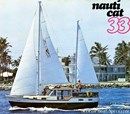

Siltala Yachts Nauticat 33 - - 1/6
Picture extracted from the commercial documentation © Siltala Yachts
Picture extracted from the commercial documentation © Siltala Yachts
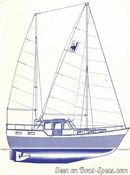

Siltala Yachts Nauticat 33 sailplan - - 2/6
Picture extracted from the commercial documentation © Siltala Yachts
Picture extracted from the commercial documentation © Siltala Yachts
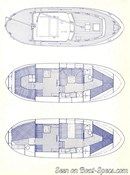

Siltala Yachts Nauticat 33 layout - - 3/6
Picture extracted from the commercial documentation © Siltala Yachts
Picture extracted from the commercial documentation © Siltala Yachts
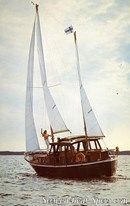

Siltala Yachts Nauticat 33 sailing - - 4/6
Picture extracted from the commercial documentation © Siltala Yachts
Picture extracted from the commercial documentation © Siltala Yachts
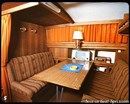

Siltala Yachts Nauticat 33 interior and accommodations - - 5/6
Picture extracted from the commercial documentation © Siltala Yachts
Picture extracted from the commercial documentation © Siltala Yachts


Siltala Yachts Nauticat 33 interior and accommodations - - 6/6
Picture extracted from the commercial documentation © Siltala Yachts
Picture extracted from the commercial documentation © Siltala Yachts
Similar sailboats that may interest you:
Sailboats
First built hull
Hull length
1966
33’ 5”10.18 m
1967
34’ 5”10.5 m
1986
30’ 11”9.42 m
2007
32’ 8”9.97 m
1986
28’8.54 m
1991
34’ 4”10.44 m
1972
31’ 2”9.5 m
1971
30’9.14 m
1986
29’ 11”9.12 m
1985
32’ 10”10 m
1999
34’ 1”10.4 m
1978
34’ 7”10.54 m
2006
34’ 10”10.6 m
1972
38’ 8”11.8 m
1979
39’ 2”11.95 m